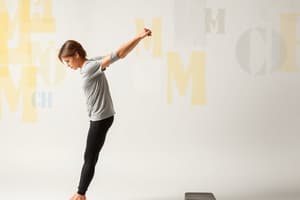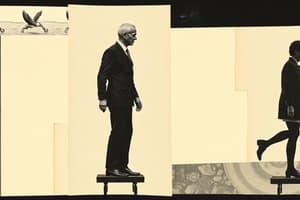Podcast
Questions and Answers
What is the ultimate goal of functional assessment tools in gait assessment?
What is the ultimate goal of functional assessment tools in gait assessment?
- To identify sensory deficiencies
- To achieve the greatest possible patient functional independence (correct)
- To evaluate motor strategies used to maintain postural control
- To establish a treatment plan with short and long term goals
What is the normal speed of an adult on flat ground?
What is the normal speed of an adult on flat ground?
- 100 m/min
- 92 m/min
- 78 m/min
- 82 m/min (correct)
What is the purpose of the Figure of 8 walk test?
What is the purpose of the Figure of 8 walk test?
- To evaluate motor strategies
- To monitor cadence
- To evaluate sensory deficiencies
- To assess functional ambulation skills (correct)
What is a limitation of traditional scales used in gait assessment?
What is a limitation of traditional scales used in gait assessment?
What is the purpose of the Ranches Los Amigos Walking Ability Questionnaire (RLAH)?
What is the purpose of the Ranches Los Amigos Walking Ability Questionnaire (RLAH)?
What is the function of the Step watch activity monitor?
What is the function of the Step watch activity monitor?
What is a key aspect of evaluating posture, balance, and gait in each patient?
What is a key aspect of evaluating posture, balance, and gait in each patient?
What happens when correlated systems try to compensate for deficits?
What happens when correlated systems try to compensate for deficits?
What is the purpose of the Berg Balance Test?
What is the purpose of the Berg Balance Test?
Which of the following is a motor strategy used in equilibrium evaluation?
Which of the following is a motor strategy used in equilibrium evaluation?
What is the purpose of the Sensory Organization Test (SOT)?
What is the purpose of the Sensory Organization Test (SOT)?
Which of the following is not a limitation of the assessment of functional skills?
Which of the following is not a limitation of the assessment of functional skills?
What is the purpose of the Time Up and Go test (TUG)?
What is the purpose of the Time Up and Go test (TUG)?
What is the purpose of the Reach Test?
What is the purpose of the Reach Test?
What is gait?
What is gait?
What is the purpose of the Activities-specific Balance Confidence (ABC) Scale?
What is the purpose of the Activities-specific Balance Confidence (ABC) Scale?
What is the primary focus of assessing a patient's ability to maintain postural control?
What is the primary focus of assessing a patient's ability to maintain postural control?
Which test is used to evaluate a patient's ability to maintain equilibrium during movement?
Which test is used to evaluate a patient's ability to maintain equilibrium during movement?
What is the primary goal of using sensory strategies in postural control assessment?
What is the primary goal of using sensory strategies in postural control assessment?
Which of the following tests is used to evaluate a patient's ability to maintain postural control during disturbances caused by an examiner?
Which of the following tests is used to evaluate a patient's ability to maintain postural control during disturbances caused by an examiner?
What is the primary focus of motor strategies in postural control assessment?
What is the primary focus of motor strategies in postural control assessment?
Which of the following tests is used to evaluate a patient's ability to maintain postural control during voluntary and involuntary movement?
Which of the following tests is used to evaluate a patient's ability to maintain postural control during voluntary and involuntary movement?
Flashcards are hidden until you start studying
Study Notes
Assessment of Functional Skills
- Evaluation of daily tasks requiring postural control to identify underlying motor, sensory, and cognitive impairments contributing to imbalance
- Limitations: does not evaluate change of context situations or movement quality
Balance Assessment Scales
- Activities-Specific Balance Confidence (ABC) Scale
- Falls Efficacy Scale-International (FES-I)
- Berg Balance Test:
- Measures balance in elderly and neurological patients
- Assesses functional tasks
- 14-item scale with scoring system (0-56 points)
- Interpretation:
- 41-46 points: low fall risk
- 21-40 points: medium fall risk
- 0-20 points: high fall risk
Evaluation of Equilibrium Strategies
- Motor Strategies:
- Alignment: sitting and standing position assessment using plumb line, static force plates, and scales
- Movement Strategies: patient ability to maintain postural control while changing positions
- Sensitive Strategies:
- Romberg Test
- Dynamic posturography
- Sensory Organization Test (SOT)
- Visual Strategies: ability to organize and select sensory information in response to changing visual conditions
Gait Assessment
- Gait is a neuromuscular and musculoskeletal action requiring coordination of legs and multiple joints and muscles
- Problems with mobility management are crucial to solve when regaining functional independence
- Functional assessment tools: define deficits, establish a treatment plan (short and long-term goals), and achieve maximum patient functional independence
- Functional test must consider:
- Functional skills
- Motor and sensory strategies used to maintain postural control in various contexts and tasks
- Sensory, motor, and cognitive deficiencies that limit postural control
Gait Strategies
- Cadence: 111-117 steps/min
- Speed: normal speed on flat ground = 82 m/min (adult)
- Monitoring tools: stopwatch, podometer, step watch activity monitor
- Assessment tools:
- Hoffer Functional Ambulation Scale
- Figure of 8 walk test
- Gillette Functional Assessment Questionnaire
- Evaluation of gait strategies:
- Functional Ambulation Classification
- Ranches Los Amigos Walking Ability Questionnaire (RLAH)
- Rivermead Visual Gait Assessment (RVGA)
- Motor Assessment Scale
Studying That Suits You
Use AI to generate personalized quizzes and flashcards to suit your learning preferences.





